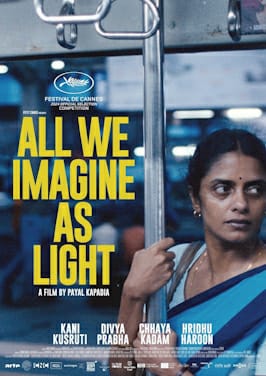(Woven with stunningly cinematic audio-visual language, this Film what oscillates between tenderness and raw intensity, calls for a neo form of criticism that can resonate with its visuo-poetic complexity.)
“Cinema is not an art which films life – cinema is something between art and life”- -Jean Luc Godard
Thus the French Maverick Master Filmmaker envisaged the understanding of Cinema through rather a theological manifesto of art of lives in the silver screen. Since Godard’s passing, with that conviction of understanding, I had made a pledge not to go to a theater to watch a film unless an immensely important happening pulses my mind at this era oozing digital dystopia! Payal Kapadia with her sheer brilliance, whether from her background of resistance or ingenious capabilities, had me to break off my pledge and made me travel 300 miles to watch her this film which is a sincere poetic resonance on celluloid!
Payal Kapadia’s journey as an independent filmmaker is something of a celebrated defiance, artistic resilience, anti-establishing aura and deep meaningfully sensitive-emotional engagement with cinema as a tool of resistance and pure love. Emerging from the prestigiously legendary Film and Television Institute of India (FTII), Pune, Kapadia has been in the realm to have carved a path through her earlier resonantly vibrant works like ‘afternoon clouds’ (2017),A night of Knowing Nothing (2021) what could defy the commercial constraints and embracing a deeply personal, lyrical, political, ‘femino-versed’ magical form of ‘quiet’ storytelling.
Mumbai is the ‘Mayanagari’ where numberless people come daily to weave their dreams. The surreal ethos of such Mumbai wreaths a garland of illusion, an illusion of hope and humanity! Furthermore the illusion of dream and imagery. Payal engulfs that obvious epiphany throughout the film. As soon the cine-projector starts, I started to get marveled with a lot of semantic chunks mixing in my brain: Of sounds, of images, of fleeting glimpses, of dialogues, and of cross-currents.
With the incredibly visceral documentary-splashed opening scene of moving camera at a close pace depicting the saga of migrant people’ (coming from different parts of country in the hope of improving their lives yet struggle to be embraced by the city as its own) symphonizes the starting mood. Bustling to work, their thoughts expressed in rapturing voiceovers in Marathi, Malayalam, Bhojpuri, Bengali languages make the thread imbibing. Juxtapositional views of many glimpses overlap and resonate the setting theme of film: Human hearts of alienation, loneliness, urges, drives, metaphors and love. The film thematizes the soft, bluish haze of deluged city, signaling its resilient color palette with a gradient sky view; it continues to depict visually the dimly illuminated building with their windows flickering like distant stars with a frequent sequence of Mumbai ‘Life Line’ Trains and its ethereal nuances.
Storyline Thread:
This cinema is a deeply visual poetic and meditative resonance that followed the lives of three women in Mumbai, capturing the ethos their quiet struggles, unspoken desires, longing for love, and fleeting moments of freedom. Chief nurse Prabha (Kani Kusruti) and her younger student-cum- colleague Anu (Divya Prabha) share a tiny cramped apartment, while Parvaty (Chhaya Kadam), an older cook, faces eviction from the tenement what she has called ‘home’ for over two decades. Without melodramatizing the episodic path, Payal lets their stories unfold organically, seeping into our conscience like some whispered confessions.
Story unfolds as it seems to tell that Prabha’s husband left for Germany years ago and has since vanished from her life. Now, a doctor (Azees Nedumangad) at the hospital subtly expresses his genuine interest on her, yet she remains uncertain -adrift between past and present, between duty and desire. Anu, in contrast, is caught in the urgency of young love . She is involved with a Muslim guy namely Shiaz (Hridhu Haroon) with an evolving spirited inter-cast relationship confined to stolen moments amid the harping noises of the city. On the other hand Parvati, the oldest among, is already seemingly disillusioned with the outer world created by patriarchal fume and capitalistic venture, is looking to figure out for a liberative solution and want to go back to her ancestral village. In one of the formative moments she laments by seeing the skyscraper of Mumbai, “Kabhi kabhi lagta hain itna bara bara building banake yeh log hi ekdin bhagwan ban jayega”(Sometimes it feels that they will become the God by making all these big buildings! ). The film follows a unique narrative in languages also with harmonious feature characters hailing from Kerala (in real life too) speak in Malayalam, (Doctor’, a true lover of Prabha, an unsung poet, struggling to speak Hindi almost makes a beautiful caricature on Hindi Language by Malayali and South Indian People!), and Parvati hailing from Maharashtra (in real life too) speaks in accented Hindi (Marathi based). A beautifully perceivable cut from interior to outer, hues. Of Tones. Shades of characters. Glancing contrasts of moments and sounds, all are harmonized to carry forward the cinema. An unknown parcel gift as rice-cooker for Prabha, seemingly coming from her husband tones the moody encapsulation into a new height. Finally Film makes its natural voyage to the sea-scenic beauty of coastal Ratnagiri where the two followed to the Parvati’s ancestral house. They share the moment of enjoyment and ecstasy! Anu and Parvati dance with popular 70s hindi song with a gulping of old alcohol, Prabha for the first time gazes at them with pure ecstasy! A world of own power in womanhood has been created with spontaneity. Film adopts a more introspective tune- at the penultimate course, Prabha encounters a man : she rescues from drowning, who, in a dreamlike hypothesis of surreal twist, claims to be her husband seeking for forgiveness. The film culminates with the three women, along with Shiaz, sharing a moment of camaraderie at a beachside tea shop. It ends with a PURE MAGIC shot which is internalized to be felt. The film does not offer resolutions. Instead, it lingers in the imperfections of life, in unanswered questions, in the spaces between love, loneliness and deeper metaphysics. Payal Kapadia deeply contemplates through the celluloid creation and challenges us to rethink the meaning of ‘Imagine’ and ‘Light’.
(To Be Continued . . .)
(Arijit Ray, an Independent Scholar & Faculty and an Ardent Cinephile. Santiniketan, West Bengal/ Bodhgaya, Bihar)
(Image Courtesy: Official Poster of the Film)
(The article is solely the opinion of the author. The views expressed here are solely personal and not in any way connected to any organisation or any political party.)
(Arijit Ray, an Independent Scholar & Faculty and an Ardent Cinephile. Santiniketan, West Bengal/ Bodhgaya, Bihar)

